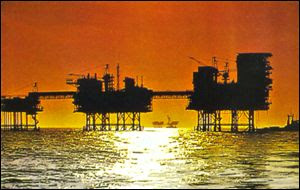Roc Oil (Cabinda) Company, a wholly owned subsidiary of ROC, advises that the Massambala-1CH2 sidetrack hole has reached a prognosed total depth of 491 metres and wireline and coring programmes have been completed. The sidetrack hole was drilled to evaluate a shallow oil zone intersected by Massambala-1, ROC’s first exploration well in Angola.
On 27 August 2007, Massambala-1CH2 was suspended for possible re-entry in order to determine the commercial merit of the discovery. Laboratory analyses have been initiated with regard to the fluid and core samples obtained from the sidetrack well and results are expected during the next several weeks. In the meantime, a preliminary interpretation of currently available data provides the following insights:
- The oil is mobile, not residual.
- Visually, the oil appears to be heavy and viscous, but definitive comment must await laboratory analysis. In any event, the oil seems to bear comparison to many crudes that are currently being routinely produced in other parts of the world via standard heavy oil industry production techniques.
- Although there appears to be a 1 to 2 metre oil sand higher in the section, the sidetrack confirmed that the main zone of interest is a 16 metre gross oil column with approximately 15 metres (94%) of net oil saturated sand with good to excellent reservoir qualities and an associated wireline log anomaly.
At the depth of the shallow oil accumulation, approximately 400 metres, the Massambala feature is currently mapped on 3D seismic data as a gentle four-way dip structure with a vertical relief in the order of 16 metres at the well which is located a few metres below the structure’s high point. As currently mapped, the area of structural closure is approximately 26 sq km/6,400 acres and based on an apparent oil-water contact identified in the well, it would seem that the shallow Massambala structure is filled to spill.
It is far too early to comment specifically on potential recoverable reserves at Massambala but volumetric calculations, based on the most recent 3D seismic mapping and available well data, suggest the in-place oil resource potential could be in the order of 170 MMBO. In a more generic sense and subject to specific field details, heavy oil recovery techniques can recover a minimum of 10% of the oil in-place, often about 20% and sometimes considerably more.
Commenting on the Massambala results, ROC’s Chief Executive Officer, Dr John Doran, stated, "After drilling the original Massambala well last month, there were two main concerns about the shallow oil accumulation: is it residual and, if not, is the oil too heavy to be produced via conventional heavy oil industry techniques? The sidetrack tells us that the oil is not residual and, even if it is heavy, it may still be producible.
Heavy oil production techniques are an established and increasingly important, subset of the upstream petroleum business, particularly in countries such as Canada and Venezuela. Therefore, although ROC’s primary exploration target in Cabinda continues to be the more mobile and lighter crudes typical of the region, we have had enough exposure to crudes with less amenable flow properties, through our Cliff Head, Zhao Dong and Beibu Gulf operatorships, to realise the potential importance of the oil discovery at Massambala.
 On this basis, Massambala becomes the most recent addition to ROC’s "conveyor belt" of projects which merit more thorough appraisal. In Massambala’s case, the thought that it might be possible to produce 20% or more of the in-place oil using standard heavy oil industry production techniques, provides plenty of reason for ROC and its co-venturers to take a very close look at the discovery.
On this basis, Massambala becomes the most recent addition to ROC’s "conveyor belt" of projects which merit more thorough appraisal. In Massambala’s case, the thought that it might be possible to produce 20% or more of the in-place oil using standard heavy oil industry production techniques, provides plenty of reason for ROC and its co-venturers to take a very close look at the discovery.
Finally, from a purely statistical point of view, Massambala-1 was not only ROC’s first well in Angola and its first well onshore Africa, but also the Company’s fifth exploration success out of nine exploration wells drilled in three different countries during the last 16 months."
Via: Scandinavian OiL & GasRoc Oil,Cabinda,onshore,Beibu Gulf operatorships,Massambala,Zhao Dong,Cliff Head,Massambala-1CH2,John Doran,Angola,Africa,energyblog Found this post useful? Consider subscribing to
 Baker Hughes , in its weekly rig activity report, said the number of rigs drilling for oil and gas in North America fell by one to 2,134. While that was 97 more than were working in the U.S. a year ago, the total fell a whopping 200 in Canada.
Baker Hughes , in its weekly rig activity report, said the number of rigs drilling for oil and gas in North America fell by one to 2,134. While that was 97 more than were working in the U.S. a year ago, the total fell a whopping 200 in Canada.





 “However, I think,
“However, I think, 
 On this basis,
On this basis, 
